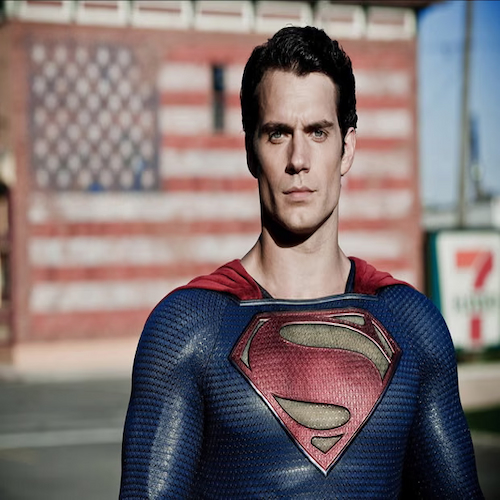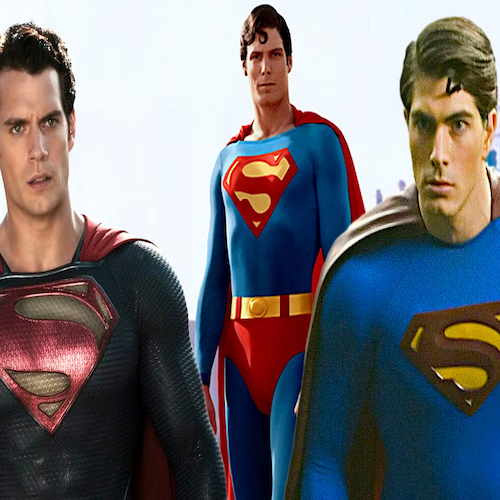The Superman Curse: The Dark Tragedies Behind the Man of Steel

A new Superman film is soaring into theaters this weekend, and audiences gather again to watch the familiar promise of Truth, Justice, and the American Way blaze across the screen. Yet beneath the bright cape and the shining heroism rests a shadowed tale. A chain of sorrow and strange fortune that trails behind the character like a ghost no one can quite see.
This story does not begin with a Hollywood star adjusting a cape before the cameras. It begins in Cleveland, with two young dreamers who shaped a legend from pencil lines and hope. They traded their creation for a check worth only $130, believing they were stepping into a golden future. Instead, they unknowingly set the first stone of a path lined with heartbreak, lawsuits, faded fame, and the quiet heaviness of dreams mishandled.
People would one day whisper that this hero carried a curse. Those who reached for his star came away scorched.
Here is the true story of the Superman Curse.
>And it begins where the sky was still low, in a small city by Lake Erie, with two boys and a hero who would change the world.
The Superman Curse, Origin
Jerry Siegel and Joe Shuster were just two teenagers from Cleveland when they imagined a hero who could leap across the sky. Their Superman was born from late-night sketches, daydreams, and a shared belief that stories could lift people higher than the ground ever allowed.
After years of closed doors and rejection letters, they finally sold their creation to Detective Comics. The payment was a single check for $130. It seemed like a small miracle at the time, a spark of hope after so much waiting. But that contract did more than sell a character; it surrendered him. Every right, every future story, every profit and adaptation, was handed over to the publisher forever.
Siegel and Shuster received no royalties. No credit beyond a line or two. No seat at the table where fortunes were being made. Their hero became a cultural icon, a symbol recognized across continents, while they watched from the margins, their names fading into footnotes.
They had given the world Superman. Yet they were already being written out of his story.
The Superman Curse, 1940s
By the 1940s, Superman had become a phenomenon. His face appeared in newspapers across breakfast tables, his voice crackled through radios in living rooms, and his animated form soared across theater screens. Toys, lunch boxes, costumes, and comics piled into the world like a flood of bright colors and capes. The hero had become larger than his creators could have imagined.
Siegel and Shuster were still writing his adventures, but the air around them had grown tense. The more Superman rose, the more the distance widened between the dream and the dreamers. In 1948, Siegel went to court to claim the rights to Superboy. He won a modest settlement, but the victory felt hollow.
The cost was brutal.
Their names were stripped from the comics. Their hands were removed from the stories. They were pushed out of the universe they had built, exiled from the hero they had pulled from imagination into immortality.
Superman continued to fly.
But his creators stood on the ground, watching their own star blaze without them.
1950s
By the 1950s, Joe Shuster’s eyesight had faded, and with it his livelihood. He lived in poverty, nearly blind, struggling day to day. Jerry Siegel, meanwhile, sat in a cramped apartment, jobless, bitterness deepening with every passing year. The hero they had created was everywhere, yet they themselves were slipping into obscurity.
In 1951, Siegel began to send letters to the executives at DC, including company president Harry Donenfeld and editor Jack Liebowitz. In these letters, he claimed that they had taken everything from him, shattered his career, and left his life in ruins. He wrote that he would never stop reminding them of the damage they had done, even saying that he wished the weight of that injustice would follow them long after he was gone. His words carried a haunting fervor, like someone crying out from the edge of a cliff.
One of the letters arrived with a sprinkle of white powder folded inside. The executives, alarmed, sent it to be tested in a lab. It turned out to be nothing more than cornstarch. But the gesture itself spoke loud enough: Siegel felt robbed, cornered, and desperate to make his pain seen.
POETRY
He even wrote a short poem expressing the toll the situation had taken. In it, he lamented that his home was empty, that his life felt wrecked, and he placed the blame squarely on those who had taken Superman away from him.
Meanwhile, Superman continued to soar. The character wasn’t just dominating comics; he had conquered television. A national TV show brought the Man of Steel into living rooms across America for six full seasons. Plans for a seventh were already unfolding.
And then came the first tragedy that people would later whisper about.
The actor who wore the cape on television met a dark fate, and the legend of the Superman Curse began to take shape.
The Superman Curse, Death of George Reeves
George Reeves became the Superman of a new era. For a generation of postwar American children, he wasn’t just an actor in a cape; he was the living symbol of hope, strength, and simple goodness. From 1952 to 1958, his presence filled television screens in Adventures of Superman, and his smile carried the certainty that heroes were real.
But on June 16, 1959, the story shattered. Reeves was found dead in his Benedict Canyon home, a gunshot wound to the head. He was only 45 years old.
The official report labeled it a suicide. Yet the shadows around the case refused to settle. There were no fingerprints on the gun. Bruises marked his body. A bullet hole in the floor suggested something more chaotic than a quiet ending. And the people in the house that night offered stories that shifted like smoke. Whispers rose that he had been murdered, possibly tied to a tangled affair with the wife of a powerful MGM executive. Others believed that Reeves, unable to escape the cape and deeply frustrated with the typecasting that limited his career, had fallen into despair and ended his own life.
Decades later, the speculation continued. A 1997 book, Hollywood Kryptonite, argued that Reeves had been murdered. The 2006 film Hollywoodland, starring Ben Affleck and Adrien Brody, retold the tragedy with a more ambiguous lens, leaving audiences to sit with unanswered questions.
No matter which version one leans toward, the conclusion remains the same: the first great Superman of American television met a tragic end, and the idea of the Superman Curse took on its first, haunting form.
1959 to 1965, Brief Return and Exit
In 1959, Jerry Siegel returned to DC, drawn back to the character he had birthed so many years before. He wrote Superman stories again, shaping new adventures for the hero who had once lifted his own spirits as a young dreamer in Cleveland. He also crafted tales for the Legion of Super-Heroes, trying to find a place once more in the world he had helped to create.
The Superman Curse, The return was not a homecoming.
Editor Mort Weisinger routinely belittled him, turning the office into a place of quiet humiliation. Siegel, already carrying years of regret and resentment, now endured daily reminders that he no longer held any real claim to the character who had defined his life.
In 1965, he tried again to seek justice through the courts. He filed a new lawsuit, hoping to reclaim a piece of what had been taken. But he lost, and the loss was final. His ties to DC were severed completely.
Superman continued soaring across pages, screens, and merchandise.
And Siegel, one of the men who brought him into existence, was once again left outside the world he had imagined.
1975 The Superman Curse Goes Public
When Jerry Siegel learned that Warner Bros. was preparing to launch a grand, big-budget Superman film, something in him ignited again. But it was not the spark of pride or joy. It was the old wound reopening. He wrote a manifesto and mailed it to newspapers and comic book organizations across the country, determined that the world should know what had been taken from him.
In that document, he stated that he, Jerry Siegel, co-creator of Superman, wished the movie to fail. He said he hoped audiences would avoid it and that the hero’s name would carry the weight of betrayal. Jerry wanted the film to collapse under the burden of what he described as the stench surrounding the character’s history, hoping people would turn away from it as if it were something diseased.
He was 61 years old then, working as a clerk-typist in California and making $7,000 a year. His days were spent at a desk, typing other people’s words, while the character he had imagined circled the globe as a cultural icon.
Joe Shuster, the artist who had given Superman his face and form, could no longer see the world he had once drawn. Legally blind, he lived in poverty with his brother in New York City. The hero born from their dreams had soared higher than anything else in American pop culture.
But the men who created him had been left behind on the ground.
Curse Takes Hold of Blockbuster’s Success
The film became a sensation. Superman returned to theaters as a myth reborn, gleaming on the screen with renewed promise. But as the years rolled forward, the people who stepped into his world seemed to walk into something darker. Whispers grew that Jerry Siegel’s bitter curse had taken shape, that the shadow cast by the cape stretched far beyond the screen.
Christopher Reeve, who embodied Superman with quiet nobility from 1978 to 1987, suffered a devastating riding accident in 1995. The injury left him paralyzed, and he spent the rest of his life advocating for others before passing away in 2004, at only 52 years old. To many, the fall of the Man of Steel felt almost mythic in its sorrow.

Margot Kidder
Margot Kidder, the fearless Lois Lane who sparred with Reeve’s Clark Kent, struggled publicly with bipolar disorder for decades. Her turmoil was raw, visible, and deeply human. She died in 2018, leaving behind a legacy of talent and a story marked by fragility.
Lee Quigley, the infant Kal-El in the 1978 film, never grew to see adulthood. He died at age 14, lost to solvent abuse. His was a short life woven into the earliest frame of Superman’s cinematic journey.
Marlon Brando, the great Jor-El, lived a life troubled by tragedy far from Hollywood sets. His family faced heartbreak and loss, and Brando withdrew from public life in his final years, passing in 2004. Even the actor who played Superman’s father could not escape a narrative of sorrow.
Richard Pryor, who appeared in Superman III, battled drug addiction and later multiple sclerosis. His brilliance flickered amid pain, and he died in 2005, another life touched by both triumph and torment.
These figures shared only one thing: they stepped into the orbit of the world’s most invincible hero. Yet their lives reminded the public of something far more human:
No one, not even those who wear the cape, is untouched by gravity.
The Superman Curse and Justice?
The public began to take notice. Stories of Siegel’s curse and the injustice behind Superman’s creation sparked outrage, and a movement grew. Comic artist Neal Adams became one of the loudest voices, rallying support and demanding that the men who created the world’s greatest hero be acknowledged and cared for.
The pressure worked.
>In 1975, Warner Bros. agreed to grant Jerry Siegel and Joe Shuster a modest pension of $20,000 a year, along with medical coverage. Even more importantly, their names were restored to every Superman comic. At last, the creators were credited for the hero who had become a global symbol.
It was a victory — but a faint one, arriving decades too late. The damage had already seeped deep.
In a 1981 interview, Siegel remarked that he sometimes felt as though he were only half-alive, as if he had been rescued from an old age filled with suffering. His words revealed a man who had endured far more than the public ever saw.
Joe Shuster died in 1992.
Jerry Siegel followed in 1996.
The creators of Superman left the world quietly — their hero still soaring across page, screen, and imagination, while their own story remained one of brilliance scarred by loss.
Truth, Justice, and the American Way
A new Superman movie is soaring into theaters, drawing fans eager to witness Truth, Justice, and the American Way once more. Yet behind the iconic red cape lies a tragic history, one that began not with a star on screen, but with two young creators and a modest $130 check in Cleveland.
Jerry Siegel and Joe Shuster, teenagers from Cleveland, Ohio, brought Superman into the world. After years of rejection, they sold the character to Detective Comics for a single payment. That contract stripped them of all rights; the publisher would own Superman across every medium, forever, while Siegel and Shuster received no royalties, no creative control, and no voice in the tidal wave of merchandise and media that followed. Though they had birthed one of the most influential characters on the planet, they were already being cast aside.
By the 1940s, Superman had become a phenomenon. Newspaper strips, radio shows, animated serials, and endless merchandise propelled him into the hearts of millions. Yet tensions between Siegel, Shuster, and DC escalated. Siegel sued for the rights to Superboy in 1948 and won only a small settlement, paying a steep personal price: the company removed their names from Superman stories, ending their creative involvement entirely. They were no longer credited as the creators of their own legacy.
The Superman Curse, 1950s
By the 1950s, poverty and illness shadowed their lives. Shuster was nearly blind, and Siegel struggled in a cramped apartment, unemployed and growing bitter with each passing year. In 1951, he began sending furious letters to DC executives, accusing them of destroying his career and ruining his life. In one letter, he swore he would haunt them, placing a curse on all who had taken from him. Another letter, containing nothing more dangerous than cornstarch, carried symbolism that could not be missed: Siegel felt robbed, and he wanted the world to know. He even penned a bitter poem lamenting the emptiness and despair inflicted upon him.
Superman’s influence extended beyond comics. On television, George Reeves became the face of the Man of Steel for postwar America, starring in Adventures of Superman from 1952 to 1958. But in 1959, Reeves was found dead from a gunshot wound at age 45. Officially ruled a suicide, the case remained shrouded in suspicion. No fingerprints were found on the gun, bruises marked his body, and conflicting accounts of the night only deepened the mystery. Rumors swirled of murder, frustrated ambition, or tragic despair—another life intertwined with Superman ending too soon.
The Superman Curse, Superman and Legion of Super-Heroes
Siegel returned to DC in 1959, writing Superman and Legion of Super-Heroes stories, yet he endured ridicule and humiliation in the office. By 1965, a failed lawsuit ended his relationship with the company permanently. Years later, learning of Warner Bros.’ blockbuster Superman film, Siegel issued a manifesto condemning the production and warning fans to stay away, effectively cursing the movie. By then, he was 61, working as a clerk-typist for a meager salary, while Shuster, now legally blind, lived destitute with his brother in New York.
The film succeeded, Superman soared once more, and yet misfortune seemed to follow some associated actors. Christopher Reeve, paralyzed in a 1995 accident, died at 52. Margot Kidder struggled with bipolar disorder and passed in 2018. Baby Kal-El, played by Lee Quigley, died at 14. Marlon Brando endured family tragedies, Richard Pryor battled illness and addiction, and Gene Hackman died alone in 2025 following his wife’s sudden death.
Public Outcry
Public outcry and advocacy eventually compelled Warner Bros. to act. In 1975, Siegel and Shuster were awarded modest pensions, medical coverage, and their bylines reinstated. A symbolic victory, though too late to reclaim what was lost. Siegel once reflected that he felt like “half a corpse rescued from a horrible old age.” Shuster passed in 1992; Siegel followed in 1996.
As a new Superman movie flies into theaters, the question returns: will this reboot escape the curse? Perhaps it is a coincidence, perhaps not. Superman’s legacy carries the weight of its origin, a character who stood for justice built on a foundation of exploitation. Two young men created a god, only to be left behind as others prospered.
Siegel’s words remain a warning: whenever the world feasts and celebrates, it should remember the man it left in poverty, and the spirit that watches, asking why such injustice was ever allowed.
The Superman Curse, Cost Of Creative Theft
The Superman Curse is more than a tale of misfortune. It is a story of stolen creativity and the human cost behind a cultural icon. It is about the heartbreak of watching an idea grow beyond imagination while the creators are left in the shadows. While the misfortunes that befell Superman actors may seem tragic yet ordinary, the lifelong toll on Jerry Siegel and Joe Shuster was extraordinary.
The true origin story of the Man of Steel may not be a literal curse, but like any cautionary legend, it serves as a warning: be careful who you trust. Siegel and Shuster gave the world the most beloved superhero in comic book history, yet others reaped the fortune. For decades, they fought, protested, and even “cursed” the system before finally receiving recognition and a measure of justice. Their story reminds us that even icons of truth and justice have origins steeped in exploitation—and that creators’ rights are worth defending.



